
Atlantic sturgeon are a long-lived, estuarine dependent,
anadromous fish. Atlantic Sturgeon were an important species targeted by early settlers in the Chesapeake Bay (Hildebrand and Schroeder 1928). Landings were reported to be 300,000-400,000 kg (136,000-181,000 lbs.) annually in the 1890's. High exploitation rates, degraded water quality, and the building of stream blockages reduced the population. By 1928, Atlantic sturgeon were rarely caught north of the Potomac River (Merritt 1992). Maryland closed the fishery for sturgeon in 1996. There have been no young of year Atlantic sturgeon caught in Maryland's juvenile finfish survey for the past 60 years (Speir and O'Connell 1996). As recently as two decades ago, Atlantic sturgeon were encountered so infrequently that they were considered to be biologically extirpated, or below minimum viable population size in the Chesapeake Bay (Secor et al. 1997). In recent years, a Chesapeake Bay spawning population was documented in Virginia's James River. Atlantic sturgeon observations are now routinely documented throughout the Chesapeake Bay, although many of these fish are migratory juveniles that originate from other river systems and forage throughout the mid-Atlantic. In April 2012, Atlantic sturgeon were designated as "endangered" by the National Marine Fisheries Service under the federal Endangered Species Act. The National Marine Fisheries Service assessment found that Atlantic sturgeon are in danger of extinction within a specific geographic range. They determined that there are five Distinct Population Segments of Atlantic sturgeon in U.S. waters: 1) Gulf of Maine (threatened); 2) New York Bight (endangered); 3) Chesapeake Bay (endangered); 4) Carolina (endangered) and 5) South Atlantic (endangered). Since the Chesapeake Bay Distinct Population Segments are now listed as a federally endangered species, catch or possession is strictly prohibited.
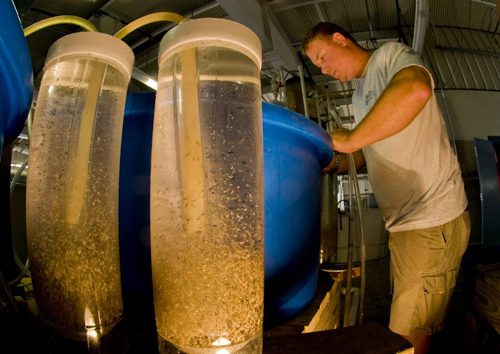
Maryland Department of Natural Resources Freshwater Fisheries and Hatcheries Division, in partnership with the University of Maryland Center for Environmental Science and the U.S. Fish and Wildlife Service, conducted an experimental release of Atlantic sturgeon in 1996. Approximately 3,300 hatchery-produced juveniles were released into the Nanticoke River, a Chesapeake Bay tributary on Maryland's Eastern Shore. A subsequent reward program recorded 462 first-time captures of these fish (14% recapture rate) between release and 2001. Multiple recaptures were frequent, indicating excellent survival after capture in commercial fishing gears. During this time, 555 wild sturgeon were also captured in the Chesapeake Bay. These fish were primarily of immature, sub-adult migratory size (16-95" in length). No wild, young of year or adult sturgeon were reported. Since a limited release of hatchery fish produced such a large number of hatchery recaptures, and no wild young of year or adults were encountered, it appears unlikely that any substantial natural reproduction occurred in Maryland during the reward program timeframe.
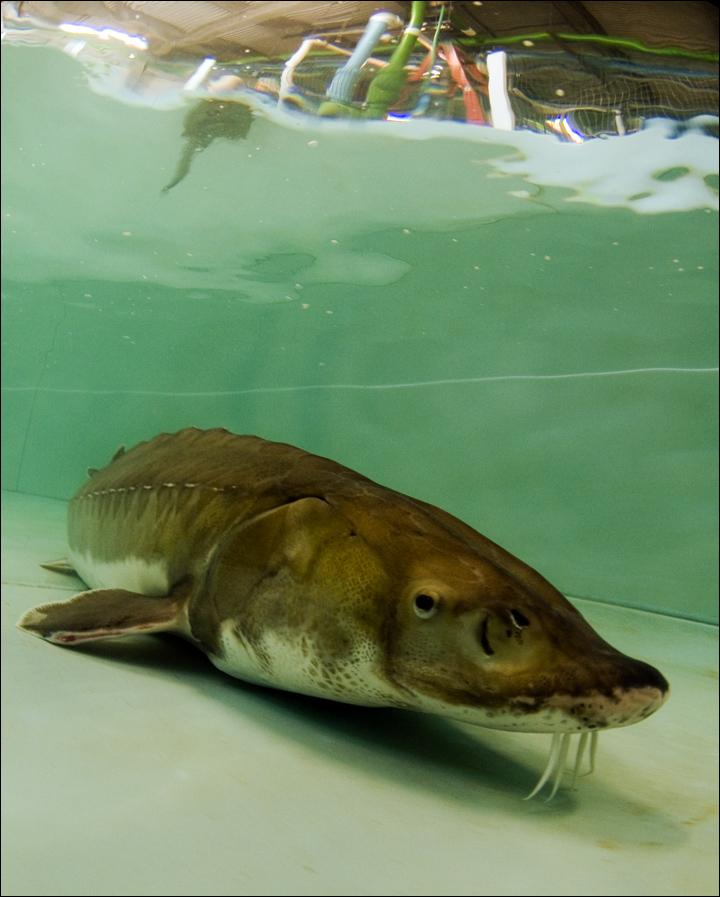
The Maryland Sturgeon Reward Program collected wild juvenile and sub-adult Atlantic sturgeon caught by commercial fishermen in the Chesapeake Bay and its tributaries from 1996-2012. Fish that were appropriate for inclusion into the captive brood population were transported to the University of Maryland's Aquaculture and Restoration Ecology Laboratory in Cambridge, MD. At this laboratory, captive brood fish were trained to consume prepared commercial diets in the hatchery. The Maryland Sturgeon Reward Program ceased operations in March 2012 due to the federal Endangered Species Act listing, which prohibits sturgeon capture and transport by commercial fishermen.
NRG Energy and The Department of Natural Resources developed another cooperative project at NRG Energy's Potomac River Generating Station, Alexandria, VA. A pilot trial for Atlantic sturgeon culture began in the summer of 2006. Positive results from the pilot effort led to an expanded culture trial in 2007. As part of the renewed partnership in 2008, NRG Energy provided funding for five years to support Atlantic sturgeon restoration activities. The Potomac River Generating Station flow-through aquaculture facility cultured Canadian origin larval and juvenile Atlantic sturgeon. The primary goal was to investigate streamside culture for imprinting purposes. Atlantic sturgeon are believed to imprint to their natal rivers, allowing them to return to spawn upon maturity. It is critical that any fish stocked as larvae or juveniles will imprint to the target tributary, so that they may successfully return to spawn. The facility also served as an education and outreach resource for sturgeon conservation specifically, and Chesapeake Bay ecology in general. In 2012, NRG Energy closed the Potomac River Generating Station and the sturgeon were transferred to the department's Manning Hatchery in Brandywine, MD. This valuable cooperative project enabled restoration biologists to develop tools and techniques that are critically important to successful hatchery-based restoration.
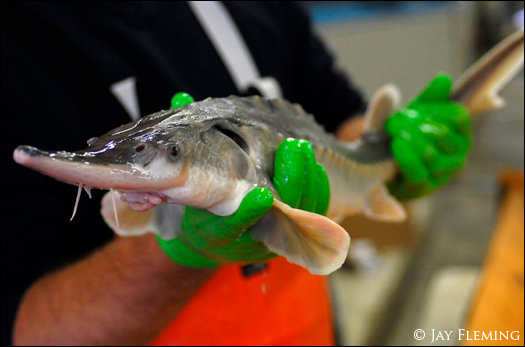
In 2013, cooperating researchers including Maryland Department of Natural Resources, Delaware Division of Fish and Wildlife, Virginia Department of Game and Inland Fisheries, Virginia Institute of Marine Science, Virginia Commonwealth University, and University of Maryland Center for Environmental Science, received a National Marine Fisheries Service grant to support an acoustic tagging and telemetry project. The project deploys and monitors receiver arrays throughout the entire Chesapeake Bay. The standardized receivers used by researchers coast-wide will detect any tagged species within ~1000 meters of deployed receivers. Receivers are monitored monthly. These data provide information on sturgeon movements throughout the Chesapeake Bay and support research efforts in other systems along the Atlantic seaboard.
Since 2014, the department’s biologists located, tagged and released thirty-seven mature adult Atlantic sturgeon in Marshyhope Creek, a major tributary of the Nanticoke River in Maryland. The Nanticoke River is a Chesapeake Bay tributary located on Maryland's Eastern Shore. This is the first time in more than 40 years that mature female sturgeon have been documented in Maryland upstream habitats. Captured fish were DNA sampled, implanted with an external t-bar tag, an internal passive integrated transponder tag, and an acoustic (VEMCO) transmitter. The VEMCO transmitter is placed into the body cavity while the fish is under sedation. The VEMCO transmitter can be detected by any researcher using compatible detection gear anywhere in the world. As a member of the Atlantic Cooperative Telemetry Network, the department can detect and identify any fish that travels into the range of receivers located throughout the Chesapeake Bay.
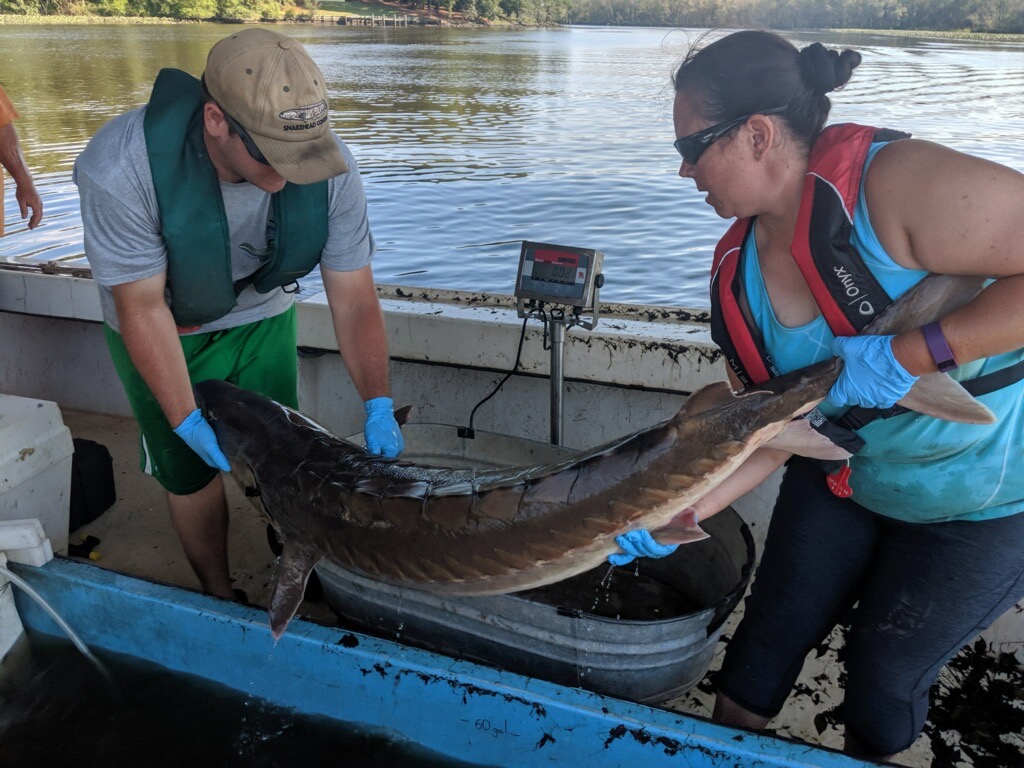
In 2013, cooperating researchers including Maryland Department of Natural Resources, Delaware Division of Fish and Wildlife, Virginia Department of Game and Inland Fisheries, Virginia Institute of Marine Science, Virginia Commonwealth University, and University of Maryland Center for Environmental Science, received a National Marine Fisheries Service grant to support an acoustic tagging and telemetry project. The project deploys and monitors receiver arrays throughout the entire Chesapeake Bay. The standardized receivers used by researchers coast-wide will detect any tagged species within ~1000 meters of deployed receivers. Receivers are monitored monthly. These data provide information on sturgeon movements throughout the Chesapeake Bay and support research efforts in other systems along the Atlantic seaboard.
The research is conducted under National Marine Fisheries Service Permit No. 20314. Project staff will continue to monitor receivers in the Choptank River, Nanticoke River/Marshyhope Creek and Pocomoke River. This study will shed light on the migratory patterns, spawning habitat preference, staging areas and wintering locations for this newly discovered spawning population. The Department of Natural Resources and our partners continue to work with the Atlantic States Marine Fisheries Commission and National Marine Fisheries Service to move forward with Atlantic sturgeon conservation efforts under the current Endangered Species Act listing status.
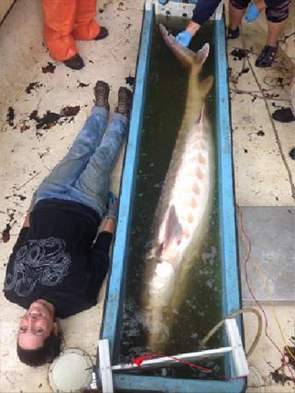
For additional information go to the links below.
Helpful Links:
For more information concerning Atlantic sturgeon in Maryland, contact Chuck Stence at 410-643-6788 ext. 2114